Pests Pesky and Not So
/8 Comments/in Gardening, Pests, Vegetables/by Lee ReichMemories
The tumbled over Red Russian kale seedling brought back old memories. It was like seeing the work of an old friend — or, rather, an old enemy. It’s been so long since I’ve seen a cutworm at work in my garden that I couldn’t even get angry at it.
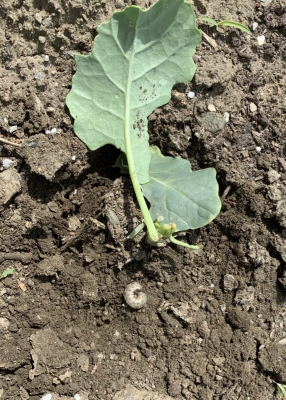
Cutworm and friend’s broccoli
I scratched around at the base of the plant to try and find the bugger. Too late, fortunately for him or her because its fate would then have been a two-finger crush. The cutworm in a friend’s garden I visited last spring was not so lucky.
The bad thing about cutworms are that they chop down young, tender seedlings. At that age, seedlings’ roots lack the energy to grow new leaves; the plants die. (I wonder how the cutworm benefits from lopping back the seedling; the felled plant usually doesn’t get eaten.)

My kale plant
The good thing about cutworms is that, in my experience, they are few and far between — just one or two every few years.
Also, on a garden scale, they’re easy to control, if needed. They prepare for their meal by wrapping their bodies around the plant stems. When I feared them more, I would cut cardboard rolls at the center of paper towels or toilet tissue into lengths of about 1-1/2 inches long, slit one site, fit it around the seedling, press it into the ground, and tape it back closed. A bit tedious, I must admit.
Then I read that cutworms can be fooled. They only attack soft, young seedlings. A thin stick or toothpick slid partway into the ground next to a seedling makes a cutworm think the plant is a woody plant and, hence, out of its league. Since I didn’t find the culprit in my garden, I slid thin sticks next to nearby seedlings. For my friend’s garden, I returned from her kitchen with a handful of toothpicks and instructed her teenage son what to do with them.
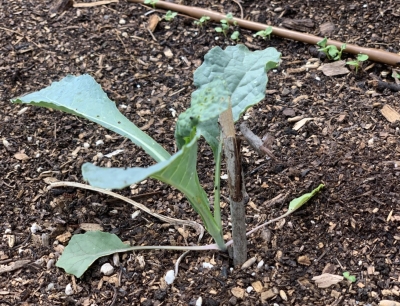
Except for today, I haven’t taken precautionary measures against cutworms for many years. Especially every morning, robins, catbirds, and mourning doves are pecking around the ground in my garden; I suspect that’s one explanation for the lack of cutworms.
A Good Parasite
A week or so ago, I saw another old “friend” in the vegetable garden. I noticed that leaflets had been thoroughly stripped from one region of one tomato plant. Obviously, a tomato hornworm, a voracious and rapid diner, was lurking somewhere amongst the existing foliage. A cause for panic? No!
The culprit, a green, velvety caterpillar with widely spaced, thin white stripes and some rows of black dots, is undoubtedly intimidating.
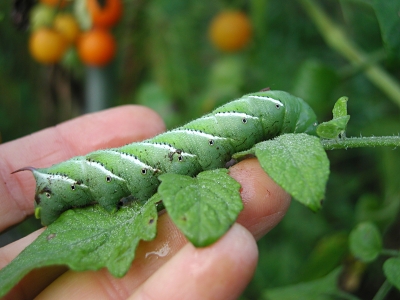
Besides its voracious appetite — you can hear it chomping away — it is the size of an adult pinky.
Still, not to worry. Like cutworms, tomato hornworms turn up in my garden only every few years. And again, like hornworms, they seem to arrive, or show evidence, solo.
I did not reach out to crush the hornworm when I saw her because her back was riddled with what looked like grains of white rice standing on end. Those “rice kernels” are actually the eggs of a parasite that in short order turns that beautiful body to an ugly mush. It’s a dog eat dog world out there.
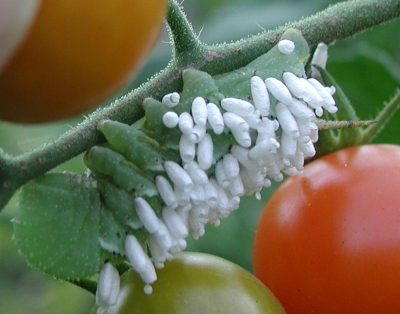
A Call for Action with This One
I can’t be so complacent about all pests that can turn up in my vegetable garden. Probably the worst one that causes problems every year is one or more of the caterpillars now, as I write, chewing away on the leaves of cabbage and its kin. The symptoms are quite evident: holy . . . whoops, holey . . . leaves upon which is deposited dark green caterpillar poop.
 A close eye is needed on cabbage and its kin because one day there’ll be no damage and next time you look, leaves are riddled with holes and poop.
A close eye is needed on cabbage and its kin because one day there’ll be no damage and next time you look, leaves are riddled with holes and poop.
And then, action is necessary. Hand-picking is one option. I choose to use the biological insecticide B.t., short for Bacillus thurengiensis and commonly sold under such names a Dipel or Thuricide. It should be used with restraint because the insects can — and, in some cases, have — developed resistance to this useful pesticide which is very specific in what it harms and what it leaves alone.
Now that I mention it, excuse me for 10 minutes while I mix up a batch of spray for my cabbages, Brussels sprouts, and kale plants . . .
I’m back. The caterpillars seem to prefer cabbage, Brussels sprouts, and cauliflower over kale, which is fine with me because kale is my favorite of the lot.
Many predators, including certain wasps and beetles, diseases, birds, and bats, keep these caterpillar pests under control. Evidently not enough, though, in my garden.
Seeds Want to Grow
/7 Comments/in Flowers, Soil, Vegetables/by Lee ReichYes, They Want To, But . . .
Today, as I was carefully planting a bed with turnip, arugula, and mustard seeds, I got to thinking how easy it is to grow plants from seeds. It’s not surprising. After all, seed plants evolved millions of years ago and over the years have further evolved to germinate and grow under varied conditions. This would be especially true of those plants we call weeds.
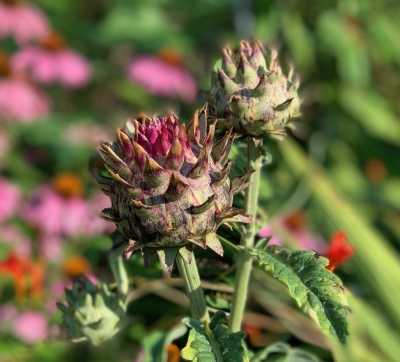
So, with all that evolution backing me up, why the great care in planting those seeds today? Seeds do want to grow, but extra care increases the chances for success. The threats to germination and growth are competition from weeds, temperatures that are too warm or not warm enough, old seed, and insufficient soil fertility, air, or moisture. That’s not all, of course; there’s too many salts in a soil (and not just NaCl “salt”), seed-eating animals, and infections from pathogenic fungi.
Whew! That list makes growing from seed seems fraught with roadblocks. But it’s not.
Steps to Improved Germination and Growth
My extra care in planting began back last autumn when I spread an inch depth of compost on top of the bed right after clearing it of garden plants and weeds. That compost provides nutrients, beneficial microbes, and increases aeration and water retention.
Earlier this season, the bed had been home to bush beans. Bean roots, left in the soil to rot, will provide further fertility — mostly nitrogen — for today’s planting.
The bean plants, and a few weeds, were cleared from the bed a couple of weeks ago, still too early for today’s planting of fall crops. While the ground was waiting, I covered it with a black tarp. The tarp, an old billboard sign (from www.billboardtarps.com and reusable for years) that is black on its back side, stimulated growth of ever present weed seeds in the soil. The seeds germinated, then died from lack of light beneath the tarp.
After year upon year of compost applications, the soil has very good tilth, so all it needed, once I removed the tarp, was a light raking to present a loose seedbed. Into it, with a trowel, I carved the first furrow the length of the bed.
Depth of planting is important. An oft-repeated rule of thumb is that the depth to sow seeds is twice their thickness. Not true! Correct planting depth needs to also take into account the looseness of the soil; looser soil, more depth. And anyway, the seeds that I planted are only about 1/32” in diameter, making it well nigh impossible to make a furrow 1/16” deep. In my loose soil, that depth would dry out too quickly. I went with the less precise “sow shallowly.”

Garden plants grown from seed can suffer from competition not only from weeds, but also from each other. True, the young seedlings could be thinned out if too crowded after germination. With seed less than two years old and care in planting, I was confident about germination, so sowed the seed thinly.
After sowing the seeds and covering them came the all-important firming of the soil. The removal of the bean plants and the pre-plant raking to smooth the surface left plenty of large pores, through which water would run right through.
Tamping down the soil with a garden rake over the covered furrow tightened up the pores so that they can hold capillary water. Remember high school chemistry class (or was it biology class) when water was shown to be drawn up into a capillary tube against the force of gravity? Firming the soil keeps moisture around the newly sown seeds; plus, water can be drawn upwards or sideways to that area. Weed seeds, sitting in still loose soil beyond the tamped area, won’t have such an easy time of it.
Finally, I watered — thoroughly enough for the water to penetrate but, to avoid washing away the seeds, not too fast. My vegetable garden has drip irrigation; I moved the drip line up right next to where the furrow was. Frequent watering is needed until seeds germinate and their new roots reach the wetting from down in the soil. An electronic moisture probe can indicate how deep moisture lies beneath the surface.
And Now for a Flower, or Is It a Vegetable?
Many years ago I grew cardoon, a vegetable whose 3-foot-high stalks are something like celery on steroids.  The flavor hints of artichoke, a close relative. None the less, for me the flavor was awful and the stalks were tough. (Cardoon is usually covered to blanche them a few weeks before harvest. Blanching did not make mine more edible.)
The flavor hints of artichoke, a close relative. None the less, for me the flavor was awful and the stalks were tough. (Cardoon is usually covered to blanche them a few weeks before harvest. Blanching did not make mine more edible.)
Yet I am now enamored with this plant — not for eating but for its thistle-like flower. Cardoon is a perennial that begins to bloom in its second year, after experiencing a period of cool temperatures in winter. Cool, not frigid; cardoon is not cold hardy here in the Hudson Valley.
Last summer I planted seed and grew the plant in pots. Those pots spent the winter in my greenhouse, where temperatures never dipping below 35° F. reminded them of their Mediterranean origin. Once warm weather settled in this spring, I planted them out in my flower garden.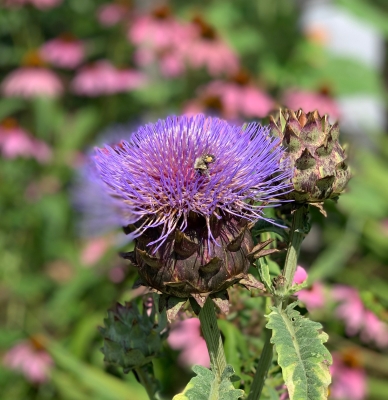
The bud on one plant that has been slowly unfurling is well worth the care I put into the plants.
Of Corn and Compost
/7 Comments/in Soil, Vegetables/by Lee ReichBed Transformation
In an hour and a half this morning, a 20’ long by 3’ wide bed of spired, aging corn stalks morphed into a bed of succulent, young greenery in the form of endive and Chinese cabbage transplants.
Before beginning this job I harvested what ears were still ripe on the stalks. The yield from this first corn planting was small, both in quantity and size of ears. Old fashioned Golden Bantam, as told by its name, normally yields small ears — but not usually as small as the 3 to 5 inch long ears I harvested. 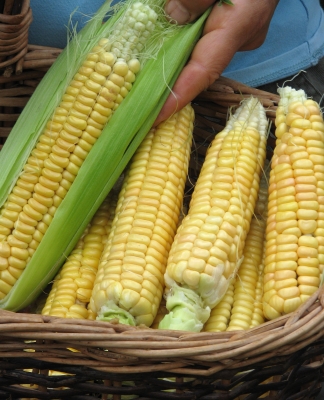
Planting in “hills” (clusters of 4 plants) usually provides for adequate pollination, but poor weather at a critical developmental stage might have thrown pollination awry.
At any rate, with ears harvested, I lopped each stalk in half with my Hori-Hori knife, then dug straight down right around the base of each hill to sever the main roots so I could jerk the cluster of stalks up out of the ground. I also cleared away from the bed any weeds, and then carted everything over to a compost pile.
For the return trip from the compost pile, I loaded the cart with finished compost from another pile. An inch depth of compost slathered on top of the old corn bed had it ready to receive the endive and Chinese cabbage transplants I had waiting in the wings. The 40 transplants had grown up during the month of July in a seedling flat and were just ready to outgrow their individual cells. Each went into a quickly made hole jabbed into the ground, the holes 15” apart in each of the two rows running down that bed.
The refurbished bed will provide good eating beginning in early October and, with some covering for protection, on into December.
Compost Discoveries
Besides merely compost, the compost pile often yields some interesting and forgotten objects. (Some annoying things as well, such as those fruit labels glued to the skin of almost every piece of commercial fruit.)
For years now I’ve had trouble bringing myself to tossing anything compostable into the garbage for eventual burial in a landfill. It seems so wasteful of materials and disrespectful to the soil to use it as a dumping ground for cast-offs. Soil is a limited resource so eventually there will be no more acreage to bury trash.
Much of my clothing is cotton, wool, or leather — natural products that would eventually decompose to enrich a finished compost. So I sometimes compost such garments, forgetting that I did so until an uncomposted piece of the garment makes an appearance as I turn the compost pile or shovel out the finished material.

Partially composted Levi jeans
The distinctive zipper and fly snap from my Levi jeans, for example. After three compost cycles, except for the zipper and fly snap, those jeans are surprisingly intact but look more like sheer polyester slacks than Levi’s jeans. In contrast, my daughter’s non-Levi jeans were threadbare after merely one cycle.
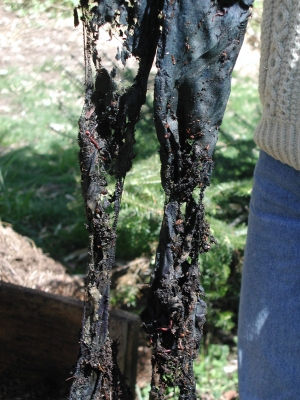
Composted (almost) non-Levi jeans
I came upon a not immediately identifiable object today as I shoveled out finished compost for spreading on the endive/Chinese cabbage bed. It was about a half inch thick, almost flat except for some bends, and spongy. What could it be? Aha! The cushioning from my sheep skin booties. Most of the leather portion had decomposed.
My guess is that the bootie was transformed as far as it would go in the near future so I’m not returning it to the new pile for another cycle.
Worms in My Ears (Some of Them)
My ears, now, are relatively large. Corn ears, that is.
Since writing about the diminutive ears from my first planting of sweet corn, I’ve harvested a few ears from my second planting. That second planting went in 2 weeks after the first planting but is ripening close on its heels. Warmer weather earlier in the season compressed those ripening dates.
Just about every ear in this second batch of ears is large (for the variety Golden Bantam) and well filled with kernels. I occasionally find a corn earworm feasting on some of the kernels at the tip of the ear. 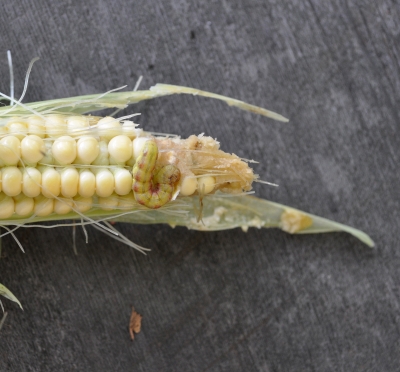
That’s the nice thing about home-grown sweet corn — it’s not nice having the earworms but it is nice not being bothered by them. Corn farmers don’t have that luxury. I just break off the tip with the worm and enjoy the rest of the ear.
The earworms got inside the husks by eating their way down the corn silks. Spraying the corn with the benign biological pesticide Bacillus thurengiensis (sold under such friendlier names as Thuricide), or cutting off or squirting some of mineral oil into the silks right after pollination is complete (3 to 7 days after silks appear) could control this pest. But why bother for an occasional pest that is so easily ignored or removed?

